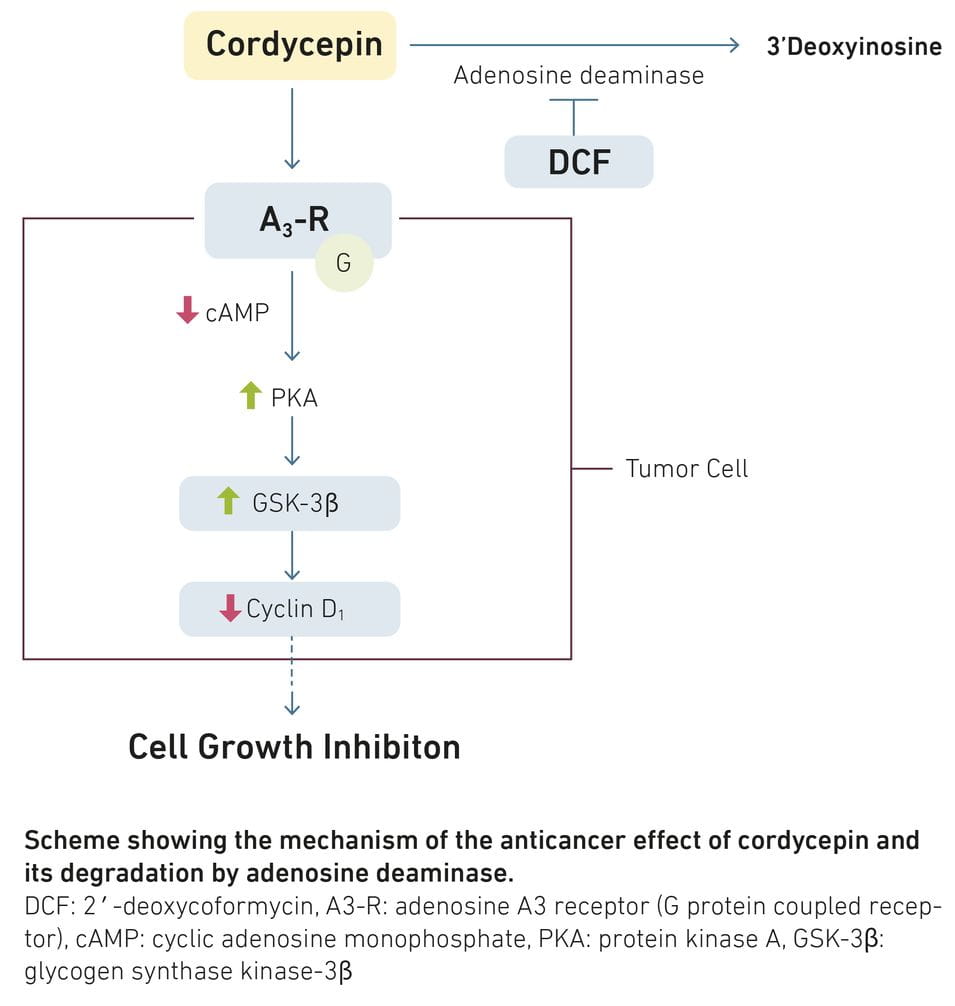|
1) Olatunji, O. J. et al. 2018. The genus Cordyceps: An extensive review of its traditonal uses, phytochemistry and pharmacology. Fitoterapia. 129:293-316.
2) Shashidhar, M. P. et al. 2013. Bioactive principles from Cordyceps sinensis: A potent food supplement – A review. Journal of Functional Foods 5, Nr. 3: 1013–1030. doi:10.1016/j.jff.2013.04.018.
3) Yue, K. et al. 2012. The genus Cordyceps : a chemical and pharmacological review. Journal of Pharmacy and Pharmacology 65, no. 4: 474–493.
4) Tuli, H. S. et al. 2013. Pharmacological and therapeutic potential of Cordyceps with special reference to Cordycepin. 3 Biotech 4, no. 1: 1–12.
5) Nie, S. et al. 2013. Bioactive polysaccharides from Cordyceps sinensis: Isolation, structure features and bioactivities. Bioactive Carbohydrates and Dietary Fibre 1, no. 1: 38–52.
6) Koh, J. H. et al. 2002. Activation of Macrophages and the Intestinal Immune System by an Orally Administered Decoction from Cultured Mycelia of Cordyceps sinensis. Bioscience, Biotechnology, and Biochemistry 66, no. 2: 407–411.
7) Wang, N. et al. 2016. Herbal Medicine Cordyceps sinensis improves health-related quality of life in moderate-to-servere asthma. Evid Based Complement Alternat Med. 2016:6134593.
8) Ong, B. Y., Aziz, Z. 2017. Efficacy of Cordyceps sinensis as an adjunctive treatment in kidney transplant patients: A systematic-review and meta-analysis. Complement Ther Med. 30:84–92.
9) Chen, S. et al. 2010. Effect of Cs-4® (Cordyceps sinensis) on Exercise Performance in Healthy Older Subjects: A Double-Blind, Placebo-Controlled Trial. The Journal of Alternative and Complementary Medicine 16, no. 5: 585–590.
10) Nicodemus, K. et al. 2001. Supplementation with Cordyceps Cs-4 Fermentation Product promotes Fat Metabolism during prolonged Exercise. Med Sci Sport Exercise. doi: 10.1097/00005768-200105001-00928.
11) Leu, S. F. et al. 2005. The in Vivo Effect of Cordyceps sinensis Mycelium on Plasma Corticosterone Level in Male Mouse. Biol Pharm Bull. 28(9):1722–5.
12) Koh, J. H. et al. 2003. Antifatigue and Antistress Effect of the Hot-Water Fraction from Mycelia of Cordyceps sinensis. Bio Pharm Bull. 26(5):691–4.
13) Yan, F. et al. 2014. Polysaccharides from Cordyceps sinensis mycelium ameliorate exhaustive swimming exercise-induced oxidative stress. Pharm Biol. 52(2):157–61.
14) Ko, B. S. et al. 2013. Cordycepin Regulates GSK-3β/β-Catenin Signaling in Human Leukemia Cells. PLoS One. 8(9):e76320.
15) Zhang, J. et al. 2011. Effect of polysaccharide from cultured Cordyceps sinensis on immune function and anti-oxidation activity of mice exposed to 60Co. Int Immunopharmacol. 11(12):2251–7.
16) Cai, H. et al. 2018. Extracts of Cordyceps sinensis inhibit breast cancer cell metastasis via down-regulation of metastasis-related cytokines expression. J Ethnopharmacol. 214:106–12.
17) Sellami, M. et al. 2018. Herbal medicine for sports: a review. J Int Soc Sports Nutr. 15:14.
References Interactions
Stargrove, M. B. et al. 2008. Herb, Nutrient, and Drug Interactions: Clinical Implications and Therapeutic Strategies. Mosby-Verlag, 1. Auflage.
Gröber, U. 2011. Mikronährstoffe: Metabolic Tuning – Prävention – Therapie. Wissenschaftliche Verlagsgesellschaft Stuttgart, 3. Auflage.
Gröber, U. 2014. Arzneimittel und Mikronährstoffe: Medikationsorientierte Supplementierung. Wissenschaftliche Verlagsgesellschaft Stuttgart, 4. Auflage.
|
